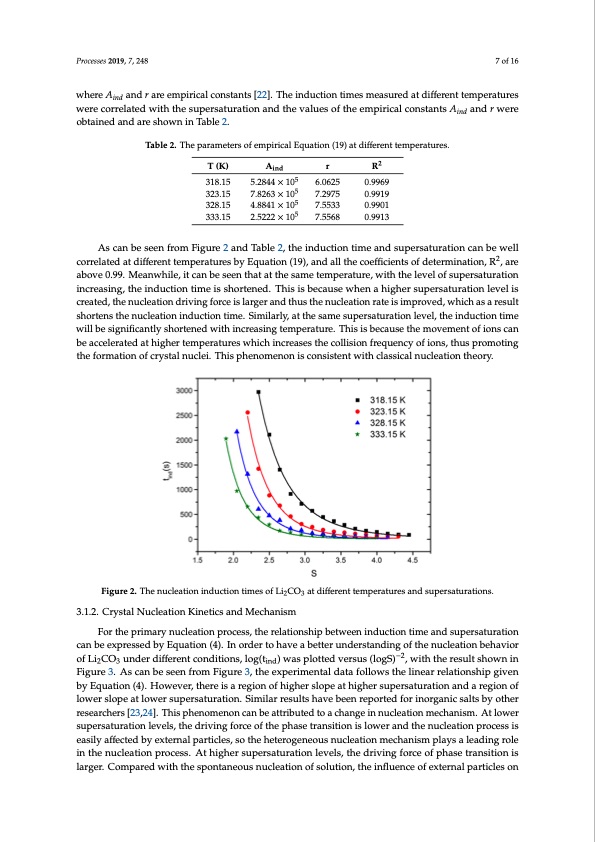
PDF Publication Title:
Text from PDF Page: 007
Processes 2019, 7, 248 7 of 16 where Aind and r are empirical constants [22]. The induction times measured at different temperatures were correlated with the supersaturation and the values of the empirical constants Aind and r were obtained and are shown in Table 2. Table 2. The parameters of empirical Equation (19) at different temperatures. T (K) Aind 318.15 5.2844 × 105 323.15 7.8263 × 105 328.15 4.8841 × 105 333.15 2.5222 × 105 r R2 6.0625 0.9969 7.2975 0.9919 7.5533 0.9901 7.5568 0.9913 As can be seen from Figure 2 and Table 2, the induction time and supersaturation can be well correlated at different temperatures by Equation (19), and all the coefficients of determination, R2, are above 0.99. Meanwhile, it can be seen that at the same temperature, with the level of supersaturation increasing, the induction time is shortened. This is because when a higher supersaturation level is created, the nucleation driving force is larger and thus the nucleation rate is improved, which as a result shortens the nucleation induction time. Similarly, at the same supersaturation level, the induction time will be significantly shortened with increasing temperature. This is because the movement of ions can be accelerated at higher temperatures which increases the collision frequency of ions, thus promoting tPhroecefsosersm20a1t8i,o6n, xoFfOcRryPsEtEaRl nRuEVclIeEiW. This phenomenon is consistent with classical nucleation theory.7 of 17 Figure2.ThenucleationinductiontimesofLiCO atdifferenttemperaturesandsupersaturations. Figure 2. The nucleation induction times of Li2CO2 3 at3different temperatures and supersaturations. 3.1.2. Crystal Nucleation Kinetics and Mechanism Generally, the relationship between induction time (tind) and supersaturation (S) can be correFlaotretdheuspirnigmtahreyfnoullcolweaitniognepmrpocireiscsa,ltehqeuraetliaotnio:nship between induction time and supersaturation can be expressed by Equation (4). In order to have a better understanding of the nucleation behavior 𝑡 = 𝐴 of Li CO under different conditions, log(t ) was plotted versus (logS) −2 (19) , with the result shown in 23 ind 𝑆 Figure 3. As can be seen from Figure 3, the experimental data follows the linear relationship given where 𝐴 and 𝑟 are empirical constants [22]. The induction times measured at different by Equation (4). However, there is a region of higher slope at higher supersaturation and a region of temperatures were correlated with the supersaturation and the values of the empirical constants 𝐴 lower slope at lower supersaturation. Similar results have been reported for inorganic salts by other researchers [23,24]. This phenomenon can be attributed to a change in nucleation mechanism. At lower and 𝑟 were obtained and are shown in Table 2. supersaturation levels, the driving force of the phase transition is lower and the nucleation process is easily affected bTyaebxlete2r.nTahleppaarrtaicmleste,rssootfheemhpeitreicraolgEeqnueaotiuosnn(1u9c)laetadtiioffnermenetcthemanpiesrmatuprleasy.s a leading role in the nucleation process. At higher supersaturation levels, the driving force of phase transition is T (K) Aind r R2 larger. Compared with the spontaneous nucleation of solution, the influence of external particles on 318.15 5.2844 × 105 323.15 7.8263 × 105 328.15 4.8841 × 105 333.15 2.5222 × 105 6.0625 0.9969 7.2975 0.9919 7.5533 0.9901 7.5568 0.9913 As can be seen from Figure 2 and Table 2, the induction time and supersaturation can be wellPDF Image | Reactive Crystallization Process of Lithium Carbonate

PDF Search Title:
Reactive Crystallization Process of Lithium CarbonateOriginal File Name Searched:
processes-07-00248-v2.pdfDIY PDF Search: Google It | Yahoo | Bing
Product and Development Focus for Infinity Turbine
ORC Waste Heat Turbine and ORC System Build Plans: All turbine plans are $10,000 each. This allows you to build a system and then consider licensing for production after you have completed and tested a unit.Redox Flow Battery Technology: With the advent of the new USA tax credits for producing and selling batteries ($35/kW) we are focussing on a simple flow battery using shipping containers as the modular electrolyte storage units with tax credits up to $140,000 per system. Our main focus is on the salt battery. This battery can be used for both thermal and electrical storage applications. We call it the Cogeneration Battery or Cogen Battery. One project is converting salt (brine) based water conditioners to simultaneously produce power. In addition, there are many opportunities to extract Lithium from brine (salt lakes, groundwater, and producer water).Salt water or brine are huge sources for lithium. Most of the worlds lithium is acquired from a brine source. It's even in seawater in a low concentration. Brine is also a byproduct of huge powerplants, which can now use that as an electrolyte and a huge flow battery (which allows storage at the source).We welcome any business and equipment inquiries, as well as licensing our turbines for manufacturing.| CONTACT TEL: 608-238-6001 Email: greg@infinityturbine.com | RSS | AMP |